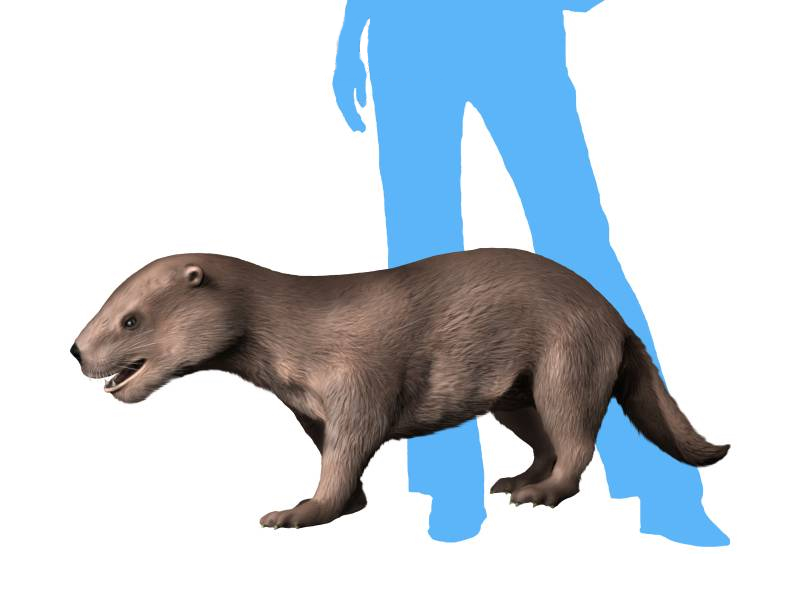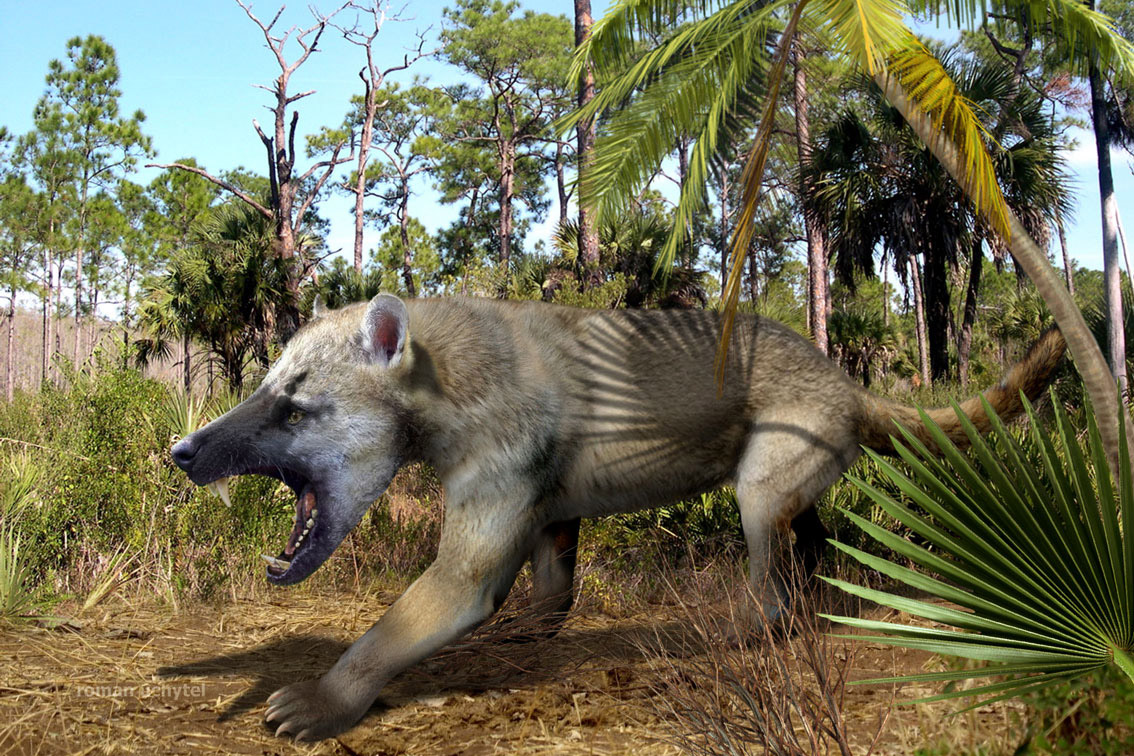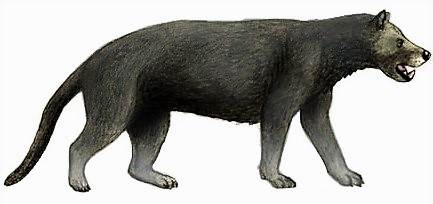|
Amphicynodontinae
Amphicynodontidae is a probable clade of extinct arctoids. While some researchers consider this group to be an extinct subfamily of bears, a variety of morphological evidence links amphicynodontines with pinnipeds, as the group were semi-aquatic otter-like mammals. In addition to the support of the pinniped–amphicynodontine clade, other morphological and some molecular analyses support bears being the closest living relatives to pinnipeds. According to McKenna and Bell (1997) Amphicynodontinae are classified as stem-pinnipeds in the superfamily Phocoidea. Fossils of these mammals have been found in Europe, North America and Asia. Amphicynodontines should not be confused with Amphicyonids (bear-dogs), a separate family of Carnivora which is a sister clade to arctoids within the caniforms Caniformia is a suborder within the order Carnivora consisting of "dog-like" carnivorans. They include dogs (wolves, foxes, etc.), bears, raccoons, and mustelids. The Pinnipedia (seals, ... [...More Info...] [...Related Items...] OR: [Wikipedia] [Google] [Baidu] |
Bear
Bears are carnivoran mammals of the family Ursidae. They are classified as caniforms, or doglike carnivorans. Although only eight species of bears are extant, they are widespread, appearing in a wide variety of habitats throughout the Northern Hemisphere and partially in the Southern Hemisphere. Bears are found on the continents of North America, South America, Europe, and Asia. Common characteristics of modern bears include large bodies with stocky legs, long snouts, small rounded ears, shaggy hair, plantigrade paws with five nonretractile claws, and short tails. While the polar bear is mostly carnivorous, and the giant panda feeds almost entirely on bamboo, the remaining six species are omnivorous with varied diets. With the exception of courting individuals and mothers with their young, bears are typically solitary animals. They may be diurnal or nocturnal and have an excellent sense of smell. Despite their heavy build and awkward gait, they are adept runners, c ... [...More Info...] [...Related Items...] OR: [Wikipedia] [Google] [Baidu] |
Parictis
''Parictis'' is an extinct arctoid, possibly the earliest genus of bears known, though a recent variety of morphological evidence links amphicynodontines with pinnipeds. It was a very small and graceful arctoid with a skull only 7 cm long. ''Parictis'' first appeared in North America in the Late Eocene (around 38 million years ago), but it did not arrive in Eurasia until the Miocene. Some suggest that ''Parictis'' may have emigrated from Asia into North America during the major sea level low about 37 mya, because of the continued evolution of the Amphicynodontinae into the Hemicyoninae in Asia. Although no ''Parictis'' fossils have been found in East Asia, ''Parictis'' does appear in Eurasia and Africa, but not until the Miocene. Species * ''P. dakotensis'' Clark 1936 37 Million years old * ''P. gilpini'' Clark & Guensburg 1972 35 Million years old * ''P. major'' Clark & Guensburg 1972 * ''P. montanus'' Clark & Guensburg 1972 36 Million years old * ''P. parvus'' Clark ... [...More Info...] [...Related Items...] OR: [Wikipedia] [Google] [Baidu] |
Kolponomos Newportensis
''Kolponomos'' is an extinct genus of carnivoran mammal that existed in the Late Arikareean North American Land Mammal Age, early Miocene epoch, about 20 million years ago. It was likely a marine mammal. The genus was erected in 1960 by Ruben A. Stirton, a paleontologist at the University of California Museum of Paleontology, Berkeley, for the species ''K. clallamensis'', on the basis of a partial skull and jaw found on the Olympic Peninsula. At the time, Stirton questionably assigned it to Procyonidae, its systematic position remained problematic until the discovery of more fossils including a nearly complete cranium from the original locality of ''K. clallamensis'' which helped identify it as part of the group from which pinnipeds evolved. Description In life, species of ''Kolponomos'' had downturned snouts and broad, heavy molars that would have been suited to a diet of hard-shelled marine invertebrates, and their narrow snouts and anteriorly directed eyes indicate that they ... [...More Info...] [...Related Items...] OR: [Wikipedia] [Google] [Baidu] |
Carnivora
Carnivora is a monophyletic order of placental mammals consisting of the most recent common ancestor of all cat-like and dog-like animals, and all descendants of that ancestor. Members of this group are formally referred to as carnivorans, and have evolved to specialize in eating flesh. The order is the fifth largest order of mammals, comprising at least 279 species. Carnivorans live on every major landmass and in a variety of habitats, ranging from the cold polar regions to the hyper-arid region of the Sahara Desert to the open seas. They come in a very large array of different body plans in contrasting shapes and sizes. Carnivora can be divided into two subclades: the cat-like Feliformia and the dog-like Caniformia, which are differentiated based on the structure of their ear bones and cranial features. The feliforms include families such as the cats, the hyenas, the mongooses and the civets. The majority of feliform species are found in the Old World, though the cat ... [...More Info...] [...Related Items...] OR: [Wikipedia] [Google] [Baidu] |
Bear Dog
Amphicyonidae is an extinct family of terrestrial carnivorans belonging to the suborder Caniformia. They first appeared in North America in the middle Eocene (around 45 mya), spread to Europe by the late Eocene (35 mya), and appear in Asia, and Africa by the early Miocene (23 mya). They had largely disappeared worldwide by the late Miocene (8 mya), with the latest recorded species at the end of the Miocene in Pakistan. They were among the first carnivorans to evolve large body size. Later in their history, they came into competition with hesperocyonine and borophagine canids. As dogs evolved similar body sizes and cranial and dental adaptations, the rise of these groups may have led to their extinction. Amphicyonids are often colloquially referred to as "bear-dogs". Taxonomy The family was erected by Haeckel (1886) lso attributed to Trouessart (1885) Their exact position has long been disputed. Some early paleontologists defined them as members of the family Canidae, but th ... [...More Info...] [...Related Items...] OR: [Wikipedia] [Google] [Baidu] |
Holarctic
The Holarctic realm is a biogeographic realm that comprises the majority of habitats found throughout the continents in the Northern Hemisphere. It corresponds to the floristic Boreal Kingdom. It includes both the Nearctic zoogeographical region (which covers most of North America), and Alfred Wallace's Palearctic zoogeographical region (which covers North Africa, and all of Eurasia except for Southeast Asia, the Indian subcontinent, the southern Arabian Peninsula). These regions are further subdivided into a variety of ecoregions. Many ecosystems and the animal and plant communities that depend on them extend across a number of continents and cover large portions of the Holarctic realm. This continuity is the result of those regions’ shared glacial history. Major ecosystems Within the Holarctic realm, there are a variety of ecosystems. The type of ecosystem found in a given area depends on its latitude and the local geography. In the far north, a band of Arctic tun ... [...More Info...] [...Related Items...] OR: [Wikipedia] [Google] [Baidu] |
Pinnipedia
Pinnipeds (pronounced ), commonly known as seals, are a widely distributed and diverse clade of carnivorous, fin-footed, semiaquatic, mostly marine mammals. They comprise the extant families Odobenidae (whose only living member is the walrus), Otariidae (the eared seals: sea lions and fur seals), and Phocidae (the earless seals, or true seals). There are 34 extant species of pinnipeds, and more than 50 extinct species have been described from fossils. While seals were historically thought to have descended from two ancestral lines, molecular evidence supports them as a monophyletic lineage (descended from one ancestral line). Pinnipeds belong to the order Carnivora; their closest living relatives are musteloids (weasels, raccoons, skunks, and red pandas), having diverged about 50 million years ago. Seals range in size from the and Baikal seal to the and southern elephant seal male, which is also the largest member of the order Carnivora. Several species exhi ... [...More Info...] [...Related Items...] OR: [Wikipedia] [Google] [Baidu] |
Pinnipeds
Pinnipeds (pronounced ), commonly known as seals, are a widely distributed and diverse clade of carnivorous, fin-footed, semiaquatic, mostly marine mammals. They comprise the extant families Odobenidae (whose only living member is the walrus), Otariidae (the eared seals: sea lions and fur seals), and Phocidae (the earless seals, or true seals). There are 34 extant species of pinnipeds, and more than 50 extinct species have been described from fossils. While seals were historically thought to have descended from two ancestral lines, molecular evidence supports them as a monophyletic lineage (descended from one ancestral line). Pinnipeds belong to the order Carnivora; their closest living relatives are musteloids (weasels, raccoons, skunks, and red pandas), having diverged about 50 million years ago. Seals range in size from the and Baikal seal to the and southern elephant seal male, which is also the largest member of the order Carnivora. Several species exhibi ... [...More Info...] [...Related Items...] OR: [Wikipedia] [Google] [Baidu] |
Pinniped
Pinnipeds (pronounced ), commonly known as seals, are a widely range (biology), distributed and diverse clade of carnivorous, fin-footed, semiaquatic, mostly marine mammal, marine mammals. They comprise the extant taxon, extant family (biology), families Odobenidae (whose only living member is the walrus), Otariidae (the eared seals: sea lions and fur seals), and Phocidae (the earless seals, or true seals). There are 34 extant species of pinnipeds, and more than 50 extinct species have been described from fossils. While seals were historically thought to have descended from two ancestral lines, molecular phylogenetics, molecular evidence supports them as a monophyletic lineage (descended from one ancestral line). Pinnipeds belong to the order Carnivora; their closest living relatives are Musteloidea, musteloids (Mustelidae, weasels, Procyonidae, raccoons, skunks, and red pandas), having diverged about 50 million years ago. Seals range in size from the and Baikal sea ... [...More Info...] [...Related Items...] OR: [Wikipedia] [Google] [Baidu] |
Arctoidea
Arctoidea is a clade of mostly carnivorous mammals which include the extinct Hemicyonidae (dog-bears), and the extant Musteloidea (weasels, raccoons, skunks, red pandas), Pinnipedia (seals, sea lions), and Ursidae (bears), found in all continents from the Eocene, , to the present. The oldest group of the clade is the bears, as their CMAH gene is still intact. The gene became non-functional in the common ancestor of the Mustelida (the musteloids and pinnipeds). Arctoids are caniforms, along with dogs (canids) and extinct bear dogs (Amphicyonidae). The earliest caniforms were superficially similar to martens, which are tree-dwelling mustelids. Together with feliforms, caniforms comprise the order Carnivora; sometimes Arctoidea can be considered a separate suborder from Caniformia and a sister taxon to Feliformia. Systematics Arctoidea was named by Flower (1869). It was reranked as the unranked clade Arctoidea by Hunt (2001), Hunt (2002) and Hunt (2002); it was reranked as t ... [...More Info...] [...Related Items...] OR: [Wikipedia] [Google] [Baidu] |
Late Eocene
The Eocene ( ) Epoch is a geological epoch that lasted from about 56 to 33.9 million years ago (mya). It is the second epoch of the Paleogene Period in the modern Cenozoic Era. The name ''Eocene'' comes from the Ancient Greek (''ēṓs'', "dawn") and (''kainós'', "new") and refers to the "dawn" of modern ('new') fauna that appeared during the epoch. The Eocene spans the time from the end of the Paleocene Epoch to the beginning of the Oligocene Epoch. The start of the Eocene is marked by a brief period in which the concentration of the carbon isotope 13C in the atmosphere was exceptionally low in comparison with the more common isotope 12C. The end is set at a major extinction event called the ''Grande Coupure'' (the "Great Break" in continuity) or the Eocene–Oligocene extinction event, which may be related to the impact of one or more large bolides in Siberia and in what is now Chesapeake Bay. As with other geologic periods, the strata that define the start and end ... [...More Info...] [...Related Items...] OR: [Wikipedia] [Google] [Baidu] |

.jpg)





